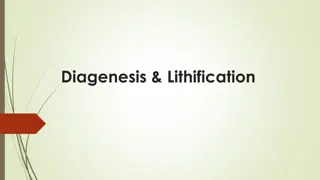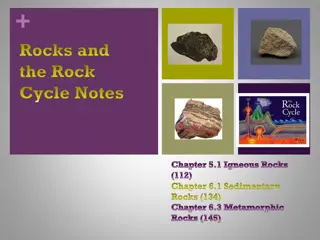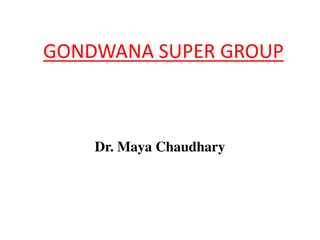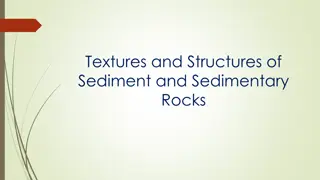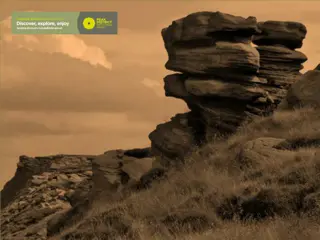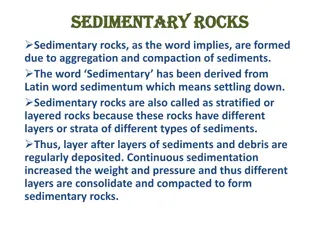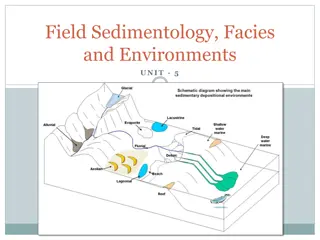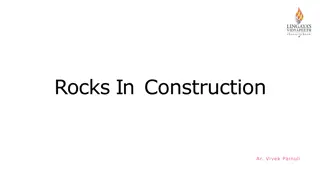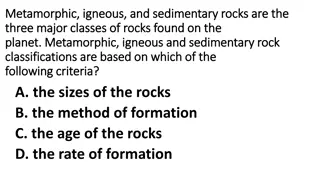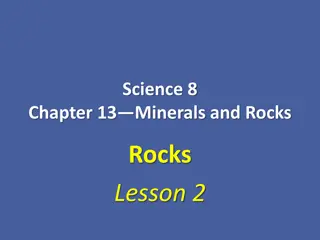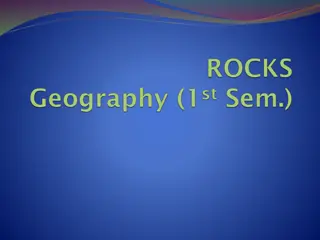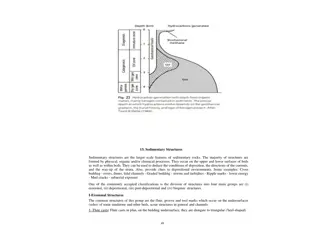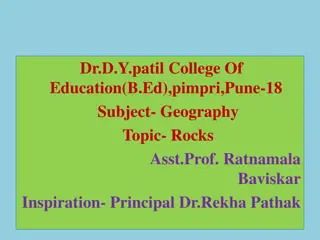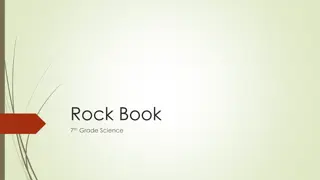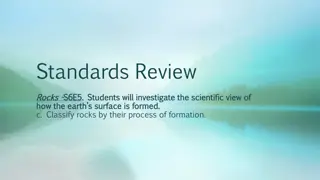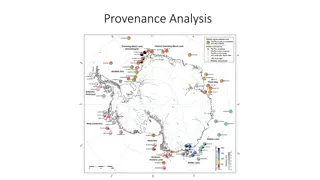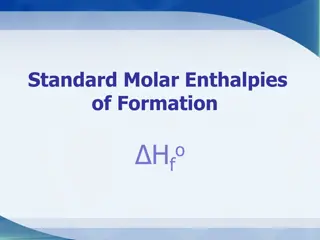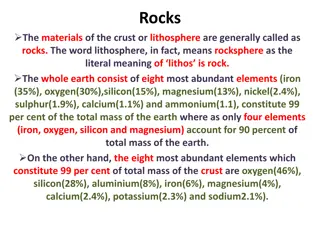Understanding Sedimentary Rocks and Their Formation
Explore the world of sedimentary rocks through detailed descriptions and images. Learn about the formation process involving sediment deposition, lithification, and the various types of sedimentary rocks such as conglomerate, sandstone, shale, and more. Discover how organic sedimentary rocks like coal are formed from ancient plant and animal materials. Enhance your knowledge of grain sizes, rock textures, and the characteristics that differentiate each type of sedimentary rock.
Download Presentation

Please find below an Image/Link to download the presentation.
The content on the website is provided AS IS for your information and personal use only. It may not be sold, licensed, or shared on other websites without obtaining consent from the author. Download presentation by click this link. If you encounter any issues during the download, it is possible that the publisher has removed the file from their server.
E N D
Presentation Transcript
SEDIMENTARY ROCK & LAB
SEDIMENT Deposits of material left by wind, water, or moving ice.
SEDIMENTARY ROCK Rock created when different grain size particles of Earth become compacted, cemented or re crystallized (lithification). Teacher note: come back to lithification on slide # 15
GRAIN SIZE FROM LARGEST TO SMALLEST Boulders Pebbles Gravel Sand Silt Clay
TYPES OF SEDIMENTARY ROCK I Clastic coarse grained to fine grained Conglomerate Breccia Sandstone Siltstone Shale
SEDIMENTARY - CONGLOMERATE Large grained Rounded pebbles or gravel compacted and cemented together.
SEDIMENTARY - BRECCAS Large grained jagged edged pebbles or gravel compacted and cemented together.
SEDIMENTARY - SANDSTONE Small grained gritty texture
SEDIMENTARY - SILTSTONE Fine grained smooth texture
SEDIMENTARY - SHALE Very fine almost no grain. Very smooth texture.
TYPES OF SEDIMENTARY ROCK II Organic made from once living organisms. Coal Limestone
SEDIMENTARY - ORGANIC Coal made from the remains of decayed plant and animal material. Peat- plant matter Lignite- brown coal/still some moisture present Bituminous- soft black coal/almost all moisture removed Anthracite hardened black coal/ almost pure carbon/ no moisture
COAL FORMATION bituminous bituminous peat peat lignite lignite anthracite anthracite
SEDIMENTARY ORGANIC Limestone begins as shells or calcium bearing animals or plants. These die and float to the bottom of the ocean or lake they inhabit. Eventually enough accumulates to create enough pressure to create limestone.
SEDIMENTARY ORGANIC Remember the word, lithifiction ? Today your going to model lithification and the processes of sedimentary rock formation. Problem: Problem: how can we model sedimentary rock formation and lithification? Hypothesis Hypothesis: If we dissolved a compound in water, and pour the water over layers of different size clasts, then let the water evaporate, then the compound should reform around the clasts as they re-crystalize. This would model how lithification binds and holds the clasts together.
SEDIMENTARY ORGANIC Background knowledge view the video to build some background knowledge.
SEDIMENTARY ROCK Materials: Materials: Wax paper Magnifying glass Water Sugar (salt?) Different sized clasts Spoon Paper cups
SEDIMENTARY ROCK Procedures: Procedures: Pour one spoonful of each clasts into a paper cup. Fill another cup with a teaspoon of water. Stir in 5 poonfulls of sugar until it is dissolved. Pour the sugar water mixture slowly into the cup clasts until it is moistened.Pour off any excess water. Let the sediment dry then carefully tear the paper cup off over a piece of wax paper. Let the sediment sit for at least 2 days. Use a magnifying glass to observe your rock. Draw an illustration of what you see. What kind of rock did you make?
SEDIMENTARY ROCK Tables A and B sedimentary layers of clasts with dissolved sugar Tables C and D mixed clasts with dissolved sugar Table E and F - sedimentary layers of clasts with dissolved salt Tables G and H -mixed clasts with dissolved salt Table I sedimentary layers of clasts with dissolved sugar AND sedimentary layers of clasts with dissolved salt.
SEDIMENTARY ROCK III Chemical sedimentary rock Evaporates


